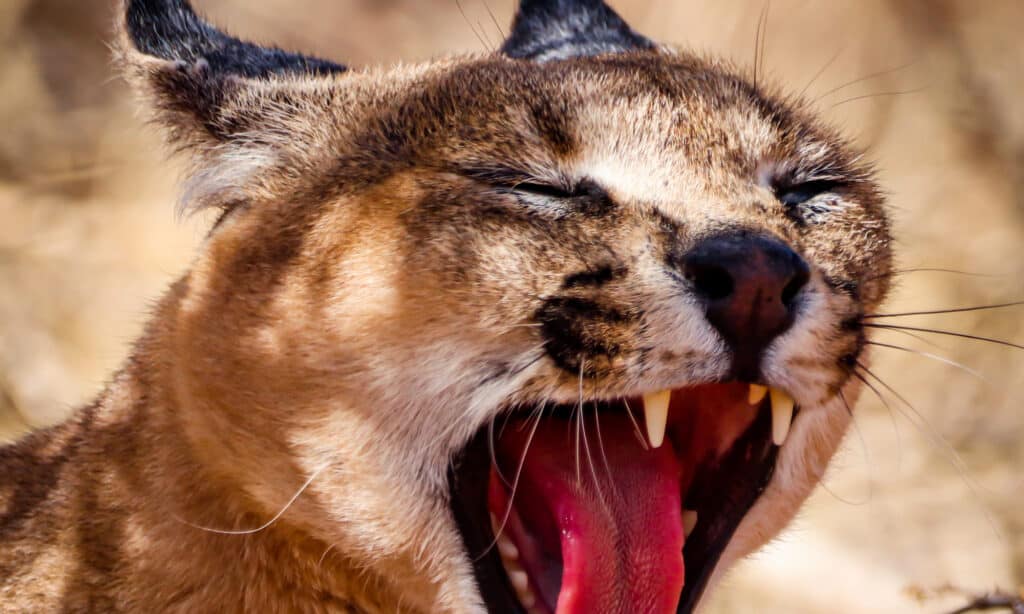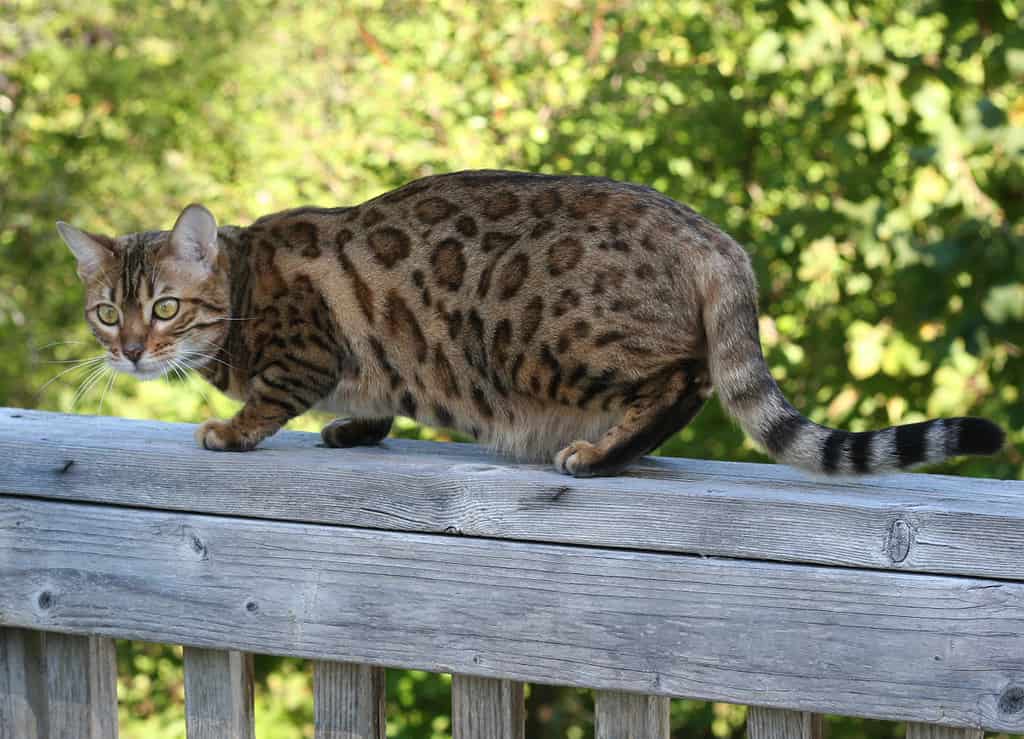Ranging anywhere from 18-42 pounds, the caracal lives in Africa, the Middle East, and Central Asia along with some parts of Pakistan and India. Usually, females are smaller than males. They sport a reddish-sandy colored coat with black ears furnished with long tufts. Caracals mostly hunt at night, typically preying on birds and small mammals. Capable of jumping up to 10 feet in the air, they’ve been known to snatch birds right out of the air! These incredible hunters remain secluded and difficult to study in the wild. Are caracals dangerous? Let’s find out below!

Strong muscles, powerful bite force, and sharp claws all make caracals dangerous.
©Derek Keats from Johannesburg, South Africa, CC BY 2.0 – License
Are Caracals Dangerous to Humans?
Some people choose to keep a caracal as a pet. This is highly inadvisable. Due to their wild nature, caracals can be dangerous to humans. Though no attacks without reason have ever been recorded on adult humans, caracals have attacked young children without being provoked. These medium-sized wildcats mature fully by the age of one year. During this time, aggression related to hormones becomes apparent. They also tend toward fits of destruction or escape attempts. Since they can run about 50 mph (miles per hour), catching an escaped caracal is quite the chore. Not to mention, a terrified escapee is more likely to lash out with teeth and claws!
Intact caracals (those not spayed or neutered) are extremely territorial, especially during the breeding season between March and October. They like to mark their territory by scratching, spraying urine, and spreading feces. This messy behavior is difficult to tolerate, especially after repeat offenses. If they feel you are threatening the area they’ve claimed, they may attack. Even if they’ve been born and raised with humans, they are still wild cats. This unpredictable nature of caracals makes them dangerous.
Are Caracals Dangerous to My Pets?

With canine teeth growing up to 1″ long, the caracal’s bite can be deadly.
©Steffen Travel/Shutterstock.com
Caracals are dangerous to other pets, without a doubt. Caracals possess an extreme prey drive. That’s the desire to hunt and kill. These carnivores require a meat-based diet to survive. Unfortunately, there’s not much anyone can do to curb this drive. Anything smaller than the caracal is potential prey in their eyes. That includes dogs, cats, rabbits, chickens, ducks, etc. Because their instincts tell them to stalk and catch prey, it’s not safe to keep them around other pets. Although a larger dog may be able to fight off a caracal, their sharp nails and claws may still do significant damage.
Part of what makes caracals dangerous is their build. Like most cat species, they’re perfectly designed to hunt and kill quickly and efficiently. A caracal’s canine teeth frequently reach lengths up to 1″ long. Their big, heavy paws have strong claws that hold them up when they climb and tear apart their prey. With a bite force of about 150-200 psi (pounds per square inch), they also have strong jaws. Think about a 200-pound nail stabbing right into the end of your big toe — that’s about what it would feel like if a caracal bites you! Not to mention, the long, sharp teeth drive bacteria from your skin and the cat’s mouth deep into your flesh. This can lead to life-threatening infection (sepsis).
Is it Illegal to Keep a Caracal as a Pet?
The answer to this question depends on where you live. Some states within the U.S. allow people to own a caracal, but many have additional rules and regulations. For instance, in South Carolina, Idaho, and Iowa, a person may own a caracal so long as they have an appropriate permit. However, in some states like Nevada, Michigan, and Alabama, no laws exist regarding the ownership of these dangerous cats.
Regardless of legality, wildlife experts strongly caution people against keeping caracals as pets. The high level of risk to both humans and other animals is too great to keep a wild animal as a pet.

Alternatives to Owning a Caracal Cat
Caracals are stunning creatures. They are strong, unique, and very interesting animals. However, owning a caracal as a pet is dangerous. It also doesn’t necessarily provide the cat with the best life. Captive caracals frequently spend a lot of time pacing, crying, and turning to destructive behavior.
If you love the wild look of the caracal but don’t have the time, money, or setup to properly care for one, consider a purebred cat that was created to look wild. Many of these breeds exist throughout the world and give you the opportunity for a unique-looking house cat that isn’t dangerous.
Bengal cats look like leopards. Savannah cats look like African servals. Even Ocicats, Toygers, and Pixie Bobs look like the wild cats that inspired their development — all without placing you in danger with a truly wild animal in your home!
Final Thoughts on How Dangerous Caracal Cats Can Be
While caracals often live well into their teen years in captivity, the best place for those unable to return to the wild is in a zoo or other appropriate facility. They need a special, raw-meat-based diet along with plenty of room to run, jump, and climb. Caracals are territorial by nature and mark their territory with urine or feces, even indoors. Not only that, they possess a high prey drive. Their sharp claws and teeth are designed for killing. All these things together make caracal cats dangerous. If you desire to own a cat with impressive wild looks and no wild cat personality, consider a specialized breed created to exhibit these features instead!
The photo featured at the top of this post is © iStock.com/MarieHolding
Thank you for reading! Have some feedback for us? Contact the AZ Animals editorial team.






